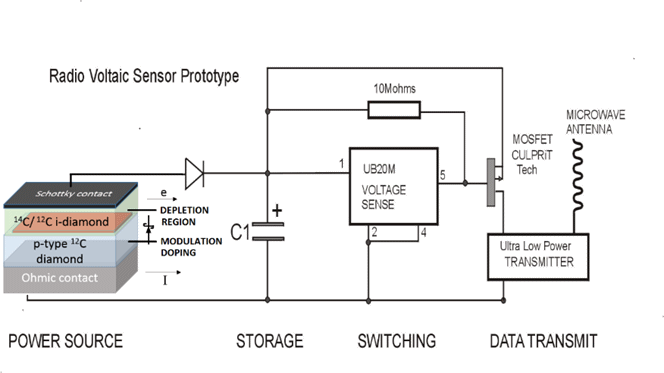 Diamond Radiovoltaic (Betavoltaic) Devices
Diamond Radiovoltaic (Betavoltaic) Devices
Diamond radiovoltaics are solid-state, energy-harvesting devices for generating microwatt power from radioactive beta decay. A key feature of these devices is that the radioactive isotope (carbon-14) is incorporated at the atomic level within the diamond voltaic device. The carbon-14 is extracted from radioactive graphite (which is the waste product from nuclear-fission power plants) by combustion with hydrogen at a UKAEA facility, such as Culham, to make 14CH4 gas. This gas can then be used as the feedstock for a CVD diamond reactor to fabricate thin layers of carbon-14 diamond, which emits beta radiation (electrons) steadily for 6000 years. These electrons can be captured and converted into an electrical current - so generating electrical power from radiaoctive decay in a compact solid-state device with no moving parts.

ESA concept for a radiovoltaic power source energizing a low-power transmitter.
An ESA-funded Discovery project has been completed by the University of Bristol that showcased the use of diamond radiovoltaics for space-power applications. During this ESA Discovery project, a collaboration between the University of Bristol and UKAEA was established that facilitated access to the Material Research Facility at Culham, and the deployment of a diamond-growth CVD system designed and built by the Bristol diamond group for the safe synthesis of carbon-14 diamond thin films using a novel synthesis method termed Static Flow CVD. This system was used to incorporate layers of carbon-14 diamond by CVD into voltaic structures for material and electrical evaluations. |
 A 512 × 512 resolution image of the glowing C-14 diamond film. The weak radio luminescence from the beta-emitting carbon-14 atoms was captured by a low-light-intensity camera. |
 "Nuclear batteries
"Nuclear batteries
Such betavoltaic devices are often called 'nuclear batteries', and in theory, they should be able to produce electrical power for thousands of years (the half-life of carbon-14 is nearly 6,000 years). The power would be small (μW or maybe mW), but the batteries could be linked together to produce higher powers, or used to trickle-charge a capacitor which can store the energy for when it's needed in a quick burst, e.g. for a distant spacecraft to send a signal back to Earth once a day. The power generated should be sufficient to power a small radio transmitter, such as a wifi link, allowing small household devices to be connected to the internet without having to plug them into the mains power or requiring frequent battery changing. Such small 'everlasting' power supplies could be crucial for enabling 'The Internet of Things'.
A spin-out company form the Bristol diamond group called Arkenlight, aims to produce and commercialise such batteries within a few years.
Related Papers
- A. Croot, G. Wan, A. Rowan, H.D. Andrade, J.A. Smith, N.A. Fox, "Beta Radiation Enhanced Thermionic Emission from Diamond Thin Films", Front. Mech. Eng. 3 (2017) 17. [DOI: 10.3389/fmech.2017.00017].
- T.B. Scott, N.A. Fox, L. Payne, C. Hutson, H.D. Andrade, Radiation powered devices comprising diamond material and electrical power sources for radiation powered devices, US Patent 11,798,703.
- N.A. Fox, H.D. Andrade, T.B. Scott, E.J. Mahoney, A. Croot, Chemical vapor deposition process for producing diamond, US Patent 11,905,594.
- A. Croot, E.J.D. Mahoney, H. Dominguez-Andrade, M.N.R. Ashfold, N.A. Fox, "Diamond chemical vapor deposition using a zero-total gas flow environment", Diamond Relat. Mater. 109, (2020) 108011. [DOI: 10.1016/j.diamond.2020.108011]
- Neil A. Fox, "Low Pressure Synthesis of Diamond by Chemical Vapour Deposition and Its Technological Applications", Chapter 5 in Elemental Carbon, ed. P.J.F. Harris. [DOI: https://doi.org/10.1039/9781839169984-00301].
